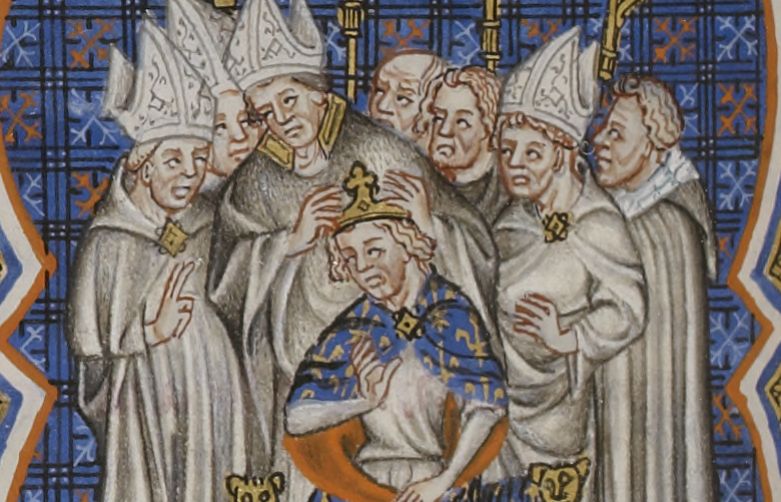By Andrew Latham
Over the last couple of months I have been writing about the disputes between kings and popes over who was more powerful and who held ultimate authority. What is the significance of this string of columns?
To begin with, this narrative arc demonstrates how, during the course of a seminal “great debate” that took place at the from the twelfth to the fourteenth century, a concept of sovereignty crystalized in Latin Christendom that would have been recognizable as such to Thomas Hobbes, Jean Bodin and other early moderns. According to this narrative, sovereignty was vested in neither pope nor emperor, but in the king. Bodin, to take perhaps the most important of the early modern theorists of sovereignty as an example, also vested supreme power in the king. Both saw the king as the “final source of authority and jurisdiction” in the temporal realm.
On this view, sovereignty entailed supreme power, not absolute power. The power of the king was limited by the nature of the royal office, divine law, the ius gentium, customary law, and even the “constitution” of the realm. Even the later Bodin, who wrote about sovereignty in increasingly absolutist terms, continued to recognize that the sovereign was limited by natural law, the fundamental laws of the realm and the inviolability of private property – even if he thought those limits unenforceable.
Beyond demonstrating the existence of a discourse of sovereignty that predates the supposed invention of that idea in the sixteenth century, this string of columns also problematizes a concept that has come to enjoy great currency in certain scholarly circles – the concept of “heteronomy”. The prevailing view in the scholarly International Relations literature is that the organizing principle of the medieval world order was not sovereignty, but “heteronomy” – a distinctively medieval system property that produced functionally differentiated polities (never states) subject to different laws of development. External sovereignty, according to this conventional wisdom, was impossible because of the universalist claims of the pope and emperor, both of whom asserted and exercised authority over kingdoms, principalities and cities. Similarly, internal sovereignty was short-circuited by feudalism, custom, and ecclesiastical and temporal “liberties”, all of which meant that there was no supreme locus of political authority within any given polity.
The result of all this, according to the narrative, was that Latin Christendom was segmented politically into a number of qualitatively distinct types of political unit – the Holy Roman Empire, the Catholic Church, city-states, urban leagues, feudal lordships, principalities, kingdoms, and even guilds and monasteries – all of which were “structured by a non-exclusive form of territoriality, in which authority was both personalized and parcelized within and across territorial formations….” By way of contrast, the modern international system is represented as comprising “territorially disjoint, mutually exclusive, functionally similar” states possessing both internal and external sovereignty.
The account developed in this series of columns disrupts this conventional wisdom by painting a relatively detailed picture of the dualist-regnalist ideal that came to dominate the Latin Christian political imagination over the course of the fourteenth century. What does this picture look like? Simply put, in locating supreme authority in the hands of the various kings of Latin Christendom, John of Paris painted a picture of a world that was naturally divided into separate kingdoms, like France and England, all of which claimed supreme authority within their borders. Even the Empire, despite its universalistic aspirations and pretensions, was to John just another kingdom among the many that populated the respublica Christiana. Having swept aside ideas of celestial hierarchy, hierocratic claims that kings held the material sword from the pope (as God’s vicar on earth), and imperialist pretensions to universal jurisdiction, John was able to sketch a (still incomplete) picture of “international system” comprising sovereign kingdoms (or sovereign states) interacting in the absence of any superior temporal or spiritual authority (i.e. anarchy). This is hardly consistent with the conventional International Relations account sketched above. Indeed, it strongly suggests that the organizing principle of the medieval world order was “sovereignty” rather than the “heteronomy” one finds in so many conventional International Relations accounts.
This is not to suggest, of course, that the late medieval understanding of sovereignty was indistinguishable from its modern counterpart. It is, however, to make the case that the differences between the late medieval ideal of sovereignty and its early modern counterpart amounted to more of a variation on a theme than a difference in kind. If we push past the temporal Othering and Orientalization of the medieval era that so thoroughly permeates the International Relations common sense to reflect on the actual ideas circulating in this period, we clearly see that a key – even defining – element of the late medieval world order was a historically distinct constitutive ideal of sovereignty that shared much in common with the one “invented” by Jean Bodin almost three centuries later.
Andrew Latham is a professor of political science at Macalester College in Saint Paul, Minnesota. He is the author, most recently, of The Idea of Sovereignty At the Turn of the 14th Century. You can visit Andrew’s website at www.aalatham.com or follow Andrew on Twitter @aalatham
Click here to read more Medieval Geopolitics
Top Image: Bibliothèque nationale de France. Département des Manuscrits. Français 2813
 www.medievalists.net/wp-content/uploads/2019/07/Grandes_Chroniques_de_France_Maître_du_btv1b84472995_688.jpg?w=781&ssl=1 781w,
www.medievalists.net/wp-content/uploads/2019/07/Grandes_Chroniques_de_France_Maître_du_btv1b84472995_688.jpg?w=781&ssl=1 781w, 













Pentru a putea adăuga comentarii trebuie să fii membru al altmarius !
Alătură-te reţelei altmarius